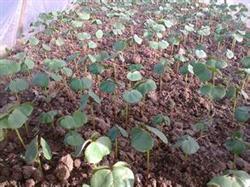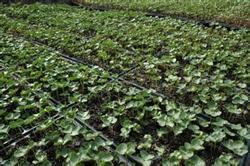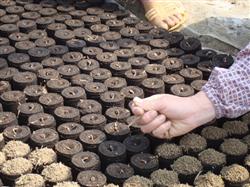Interplanting cotton with spring cauliflower and summer lettuce

In recent years, our field promotes a kind of continuous interplanting technology of planting spring cabbage in winter and spring, transplanting cotton after cauliflower harvest, interplanting summer lettuce in cotton row, except lint cotton per mu can reach about 100 kg, the total output value per mu can exceed 3000 yuan. The interplanting technology is introduced as follows: First, apply enough base fertilizer to select plots with higher fertility and better irrigation and drainage conditions. After the harvest of the previous crop, deep ploughing and freezing are carried out; before transplanting cauliflower seedlings, 2500 kg of high-quality enclosure fertilizer and 75 kg of ternary compound fertilizer are applied per mu; and then the furrow width is 133 cm and the furrow width is 33 cm. 2. Seedling and post-planting management of spring cabbage 1. Seedling selection of high-yield, high-quality, cold-resistant Japanese snow mountain varieties. Nursery in mid-November. The seedbed is leveled after applying sufficient base fertilizer, then the seeds are sown in shallow furrows, and the small arched shed is built to keep warm after sowing. Pay attention to the wind after the seedlings are complete (usually at 9 a.m. and closed at 2 p.m.) to prevent the formation of tall seedlings. Cover the film with straw at night before the cold snap strikes. On snowy days, the snow on the shed should be cleared in time. The seedling stage generally does not apply fertilizer. 2. Transplanting and post-planting management Transplanting in the morning on fine weather in late February. When transplanting, dilute manure water was used as living water, transplanting row spacing was 43 cm, plant spacing was 50 cm, 2400 plants were planted per mu, and one group was planted for every three rows. After planting, first spread plastic film, then set up small arch shed, plastic film around and each seedling root should be sealed with wet soil. After planting half a month, 50 kg ammonium bicarbonate per mu was applied; when the ball began to form, 30 kg urea was applied per mu. In case of drought, ditch irrigation should be carried out after topdressing to penetrate the surface of the bed. Keep the ridge surface wet in the late stage of ball formation, and cover the sphere with vegetable leaves to prevent contamination. During the growth period, broad-spectrum fungicides such as thiophanate-methyl were sprayed 3~4 times to prevent root rot and other diseases. Such as aphids, cabbage pest harm, should be timely prevention and control. After the Qing Dynasty, the shed was demolished. Cauliflower will be available for six consecutive years in late April. 3. Seedling and post-planting management of lettuce 1. Seedling selection of Sichuan tip leaf lettuce varieties with high quality, high yield and heat resistance. In late March, the seedlings were cultivated in the open field by broadcasting, and the seedlings were cultivated 2~3 times during the seedling period to cultivate short and strong seedlings. 2 Then, 10 cm deep furrows are drawn between the rows to be planted with cotton and lettuce, and 75 kg of ternary compound fertilizer and cake fertilizer are applied per mu. Planting is carried out on the flat ridge surface, 4 rows (equal rows) of cotton are planted in each ridge, the plant spacing is 30 cm, and 2670 plants are planted per mu; except for the furrow rows, one row of lettuce is interplanted in the interval between every two rows of cotton, the plant spacing is 43 cm, and 1380 plants are interplanted per mu. After planting, dilute manure water is poured as living water. After living trees, loosen the soil in time. After sprouting, apply fertilizer in time, 50kg ammonium bicarbonate per mu and dilute manure water. In the late drought, timely irrigation should be carried out to keep the soil moist; if there is too much rainy weather, it is necessary to clear the ditch in time. Growth period to control downy mildew, gray mold and other diseases 1~2 times, each time available 80% mancozeb spraying water. At the same time, we should control aphids and prevent virus diseases. Lettuce will be available for six consecutive years in late June.
- Prev

Prevention and treatment of premature senescence of cotton in the middle and later stage
The Spring Equinox has passed, and cotton seedling cultivation is just around the corner. In order to seize the best period for cotton seedling cultivation and timely raise cotton seedlings, in the light of this year's climate characteristics, cadres at all levels and the vast number of cotton farmers are required to earnestly do a good job in raising cotton seedlings in accordance with the following technical points. 1. The best time to raise seedlings is from late March to April 5.
- Next

The method of raising Cotton Seedling in Nutrition Bowl and moving Seedling
Moving bowls and squatting seedlings is an important measure in cotton seedling bed management. One of its main advantages is that it can break the top of the main root of cotton seedling to make the upper part grow slowly, stimulate the development of lateral root, make the plant dwarf and thick lateral root more, and improve the quality of cotton seedling; second, after moving the bowl, the root is ventilated and the water is lost quickly, which can not only enhance the root activity.
Related
- The first cup of black tea in spring, the flavor and history of tea gardens in Kenya, Africa
- The computer can not only choose potatoes, but also grow tea rice. AI will grow winter oolong tea champion.
- It is not only the inflated tea bitten by insects, but also engraved with the four seasons tea in Beipu.
- The Oriental Beauty Tea Festival in Zhuxian County takes the stage at the weekend to experience the plus-size feast of oil tea.
- & quot; Oriental Beauty Tea & Exploration of Emei in Hsinchu, the hometown of quot;
- The new variety of strawberry "Tainong 1" dessert is the first choice with mellow aroma. Crimson gorgeous
- History of Tea in Taiwan: from Wild Inner Mountain to Export Tea Garden
- Two types of Taiwan Oriental Beauty Black Tea won the British three-Star Award for Childhood Tea Xiang Zhang Jiaqi changed from pilot to champion tea maker.
- Banana species and varieties: the planting history of Taiwan Xianren banana and dwarf banana is long, is banana disease resistant?
- Coffee planting Technology: Qianjie Coffee from Seedling to harvesting

